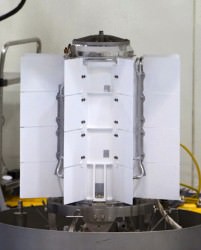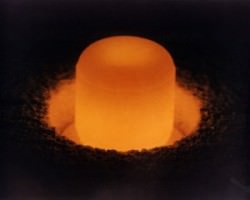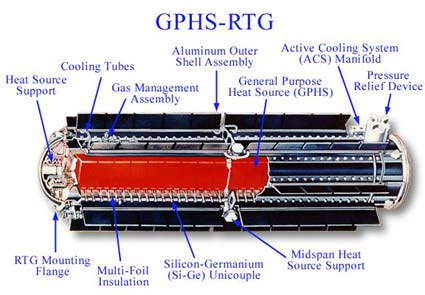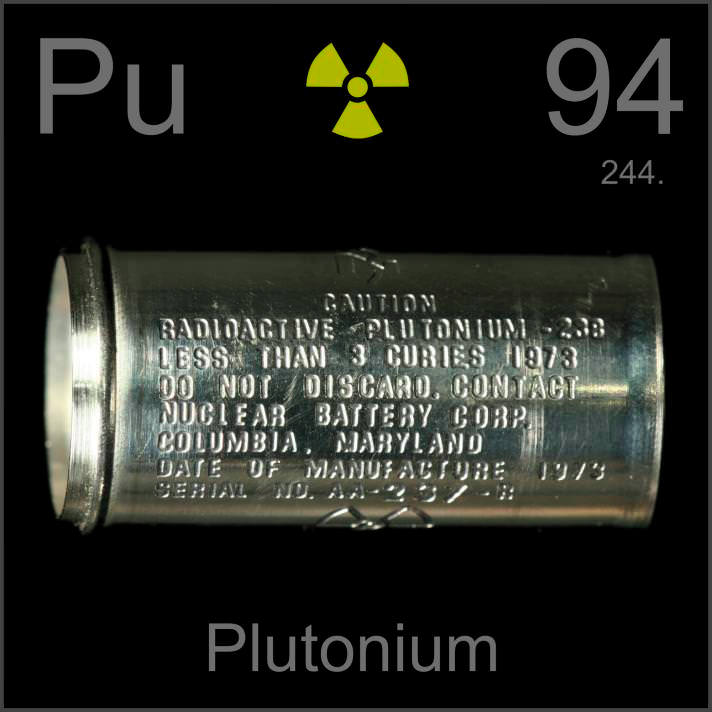[/caption]
Mars Science Laboratory, launched three days ago on the morning of Saturday, November 26, is currently on its way to the Red Planet – a journey that will take nearly nine months. When it arrives the first week of August 2012, MSL will begin investigating the soil and atmosphere within Gale Crater, searching for the faintest hints of past life. And unlike the previous rovers which ran on solar energy, MSL will be nuclear-powered, generating its energy through the decay of nearly 8 pounds of plutonium-238. This will potentially keep the next-generation rover running for years… but what will fuel future exploration missions now that NASA may no longer be able to fund the production of plutonium?
Pu-238 is a non-weapons-grade isotope of the radioactive element, used by NASA for over 50 years to fuel exploration spacecraft. Voyagers, Galileo, Cassini… all had radioisotope thermoelectric generators (RTGs) that generated power via Pu-238. But the substance has not been in production in the US since the late 1980s; all Pu-238 has since been produced in Russia. But now there’s only enough left for one or two more missions and the 2012 budget plan does not yet allot funding for the Department of Energy to continue production.
Where will future fuel come from? How will NASA power its next lineup of robotic explorers? (And why aren’t more people concerned about this?)
Amateur astronomer, teacher and blogger David Dickinson went into detail about this conundrum in an informative article written earlier this year. Here are some excerpts from his post:
________________
When leaving our fair planet, mass is everything. Space being a harsh place, you must bring nearly everything you need, including fuel, with you. And yes, more fuel means more mass, means more fuel, means… well, you get the idea. One way around this is to use available solar energy for power generation, but this only works well in the inner solar system. Take a look at the solar panels on the Juno spacecraft bound for Jupiter next month… those things have to be huge in order to take advantage of the relatively feeble solar wattage available to it… this is all because of our friend the inverse square law which governs all things electromagnetic, light included.

To operate in the environs of deep space, you need a dependable power source. To compound problems, any prospective surface operations on the Moon or Mars must be able to utilize energy for long periods of sun-less operation; a lunar outpost would face nights that are about two Earth weeks long, for example. To this end, NASA has historically used Radioisotope Thermal Generators (RTGs) as an electric “power plant” for long term space missions. These provide a lightweight, long-term source of fuel, generating from 20-300 watts of electricity. Most are about the size of a small person, and the first prototypes flew on the Transit-4A & 5BN1/2 spacecraft in the early 60’s. The Pioneer, Voyager, New Horizons, Galileo and Cassini spacecraft all sport Pu238 powered RTGs. The Viking 1 and 2 spacecraft also had RTGs, as did the long term Apollo Lunar Surface Experiments Package (ALSEP) experiments that Apollo astronauts placed on the Moon. An ambitious sample return mission to the planet Pluto was even proposed in 2003 that would have utilized a small nuclear engine.
Video: what is plutonium really like?

David goes on to mention the undeniable dangers of plutonium…
Plutonium is nasty stuff. It is a strong alpha-emitter and a highly toxic metal. If inhaled, it exposes lung tissue to a very high local radiation dose with the attending risk of cancer. If ingested, some forms of plutonium accumulate in our bones where it can damage the body’s blood-forming mechanism and wreck havoc with DNA. NASA had historically pegged a chance of a launch failure of the New Horizons spacecraft at 350-to-1 against, which even then wouldn’t necessarily rupture the RTG and release the contained 11 kilograms of plutonium dioxide into the environment. Sampling conducted around the South Pacific resting place of the aforementioned Apollo 13 LM re-entry of the ascent stage of the Lunar Module, for example, suggests that the reentry of the RTG did NOT rupture the container, as no plutonium contamination has ever been found.
Yet the dangers of nuclear power often overshadow its relative safety and unmistakable benefit:
The black swan events such as Three Mile Island, Chernobyl and Fukushima have served to demonize all things nuclear, much like the view that 19thcentury citizens had of electricity. Never mind that coal-fired plants put many times the equivalent of radioactive contamination into the atmosphere in the form of lead210, polonium214, thorium and radon gases, every day. Safety detectors at nuclear plants are often triggered during temperature inversions due to nearby coal plant emissions… radiation was part of our environment even before the Cold War and is here to stay. To quote Carl Sagan, “Space travel is one of the best uses of nuclear weapons that I can think of…”
Yet here we are, with a definite end in sight to the supply of nuclear “weapons” needed to power space travel…
Currently, NASA faces a dilemma that will put a severe damper on outer solar system exploration in the coming decade. As mentioned, current plutonium reserves stand at about enough for the Mars Science Laboratory Curiosity, which will contain 4.8kilograms of plutonium dioxide, and one last large & and perhaps one small outer solar system mission. MSL utilizes a new generation MMRTG (the “MM” stands for Multi-Mission) designed by Boeing that will produce 125 watts for up to 14 years. But the production of new plutonium would be difficult. Restart of the plutonium supply-line would be a lengthy process, and take perhaps a decade. Other nuclear based alternatives do indeed exist, but not without a penalty either in low thermal activity, volatility, expense in production, or short half life.
The implications of this factor may be grim for both manned and unmanned space travel to the outer solar system. Juxtaposed against at what the recent 2011 Decadal Survey for Planetary Exploration proposes, we’ll be lucky to see many of those ambitious “Battlestar Galactica” –style outer solar system missions come to pass.
Landers, blimps and submersibles on Europa, Titan, and Enceladus will all operate well out of the Sun’s domain and will need said nuclear power plants to get the job done… contrast this with the European Space Agency’s Huygens probe, which landed on Titan after being released from NASA’s Cassini spacecraft in 2004, which operated for scant hours on battery power before succumbing to the -179.5 C° temps that represent a nice balmy day on the Saturnian moon.
So, what’s a space-faring civilization to do? Certainly, the “not going into space” option is not one we want on the table, and warp or Faster-Than-Light drives a la every bad science fiction flick are nowhere in the immediate future. In [my] highly opinionated view, NASA has the following options:
Exploit other RTG sources at penalty. As mentioned previously, other nuclear sources in the form of Plutonium, Thorium, and Curium isotopes do exist and could be conceivably incorporated into RTGs; all, however, have problems. Some have unfavorable half-lives; others release too little energy or hazardous penetrating gamma-rays. Plutonium238 has high energy output throughout an appreciable life span, and its alpha particle emissions can be easily contained.
Design innovative new technologies. Solar cell technology has come a long way in recent years, making perhaps exploration out to the orbit of Jupiter is do-able with enough collection area. The plucky Spirit and Opportunity Mars rovers(which did contain Curium isotopes in their spectrometers!) made do well past their respective warranty dates using solar cells, and NASA’s Dawn spacecraft currently orbiting the asteroid Vesta sports an innovative ion-drive technology.
Push to restart plutonium production. Again, it is not that likely or even feasible that this will come to pass in today’s financially strapped post-Cold War environment. Other countries, such as India and China are looking to “go nuclear” to break their dependence on oil, but it would take some time for any trickle-down plutonium to reach the launch pad. Also, power reactors are not good producers of Pu238. The dedicated production of Pu238 requires either high neutron flux reactors or specialized “fast” reactors specifically designed for the production of trans-uranium isotopes…
Based on the realities of nuclear materials production the levels of funding for Pu238 production restart are frighteningly small. NASA must rely on the DOE for the infrastructure and knowledge necessary and solutions to the problem must fit the realities within both agencies.
And that’s the grim reality of a brave new plutonium-free world that faces NASA; perhaps the solution will come as a combination of some or all of the above. The next decade will be fraught with crisis and opportunity… plutonium gives us a kind of Promethean bargain with its use; we can either build weapons and kill ourselves with it, or we can inherit the stars.

Thanks to David Dickinson for the use of his excellent article; be sure to read the full version on his Astro Guyz site here (and follow David on Twitter @astroguyz.) Also check out this article by Emily Lakdawalla of The Planetary Society on how the RTG unit for Curiosity was made.
“There are some people who legitimately feel like this is simply not a priority, that there’s not enough money and it’s not their problem. But I think if you try to step back and look at the forest and not just the individual trees, this is one of the things that has helped drive us to become a technological powerhouse. What we’ve done with robotic space exploration is something that people not just in the U.S., but around the world, can look up to.”
– Ralph McNutt, planetary scientist at Johns Hopkins University’s Applied Physics Laboratory (APL)
( Top image credit © 2011 Theodore Gray periodictable.com; used with permission.)


>> Exploit other RTG sources at penalty
Actually, Gd-148 -> Sm-144 has only a slightly shorter half-life, and produces more heat energy per gram than does Plutonium … and both Gd and Sm are practically non-toxic compared to Plutonium.
It is radioactively toxic though, I see from WolframAlpha that it also produces a double beta decay.
Worse, we can’t produce enough of it:
“The five remaining radioisotopes are alpha emitters. Gadolinium-148 (148Gd) is ideal in terms of emissions because it decays directly to a stable nuclide (samarium-144) and emits no secondary radiation.2 However, 148Gd can be produced only by using a proton accelerator, rather than a reactor. Even if an accelerator were devoted full-time to the production of 148Gd, the output would be only a few grams per year. There is no known or projected method for making kg quantities of this isotope in a year’s time.”
[“Radioisotope Power Systems: An Imperative for Maintaining U.S. Leadership in Space Exploration (2009)”, Aeronautics and Space Engineering Board (ASEB) & Space Studies Board (SSB).]
Ah Torbjorn, don’t be a buzzkill!
Ah Torbjorn, don’t be a buzzkill!
The plutonium industry needs to be closed down. The whole industry is more of a nuclear warhead production system than a nuclear power system. The so called slow breeder system with thorium is really a far more rational choice for nuclear power.
http://www.motherboard.tv/2011/11/9/motherboard-tv-the-thorium-dream
Thorium power is not quite the complete panacea that it is being portrayed as here, but it is a hell of a lot better than the uranium-plutonium Rankin cycles we use. The primary advantage is that Th_232 can be converted into U_233 in a closed cycle and the U_233 is fissioned in the breeder cycle. The cycle is such that if the liquid Th is stopped the breeder cycle stops. This closed cycle means that far more of the nuclear energy in the Th is directly extracted, than what we currently get from the Pu light water reactors. Also U_233 is useless for nuclear weapons, which is one reason it was not as politically favors. A U to Pu breeder is very dangerous and is close to actually being a nuclear bomb.
The current stocks of plutonium should be cycled through reactors and fissioned away. There is about as much energy “banked” in plutonium to about equal the oil reserved in Iraq. So this should not just be wasted, but cycled through currently existing nuclear plants with the objective of fazing them out in favor of the thorium cycle. Nuclear power will then in the future play a role as the stabilizer in the power grid in association with renewable sources which have more transient features due to weather and diurnal cycles.
Space applications will then have to shift accordingly, and there are plenty of elements which decay by weak nuclear interactions which can serve in RTGs.
LC
This has nothing to do with weapon production though. Pu-238 is not weapon grade plutonium.
It is also a minute amount of the produced waste, see the article for why it is often produced by transmutation instead.
As for the reactor physics, it seems all wrong. Energy reactors aren’t Pu breeders. Nor are any reactors closely related to bombs, since there is a wide enough difference between a critical reactor and a supercritical bomb, today’s reactors can’t explode that way.
As for using inferior material in experiments, there is no scientist that do so outside of safety reasons. And there are no such issue here, production and launches being safe enough and accidents outcomes being minute. (Increased radiation at worst, something accepted for, say, fossil fuel use.)
I wouldn’t couple all these external factors (weaponization, society radiation risks) to the essential problem of doing valuable experiments.
Plutonium production at facilities such as the Savannah plant produces a wide range of isotopes 238 through 242. Only 239 is bomb grade, for the higher ones spontaneously fission making them unusable and 238 is very low yield for fission. So these are separated out. The civilian nuclear industry was set up as a way that non-bomb grade material can be used. The same hold for 238.
LC
Here’s hoping that necessity is the true mother of invention! Perhaps some bright new inventions will come of having to look away from PU-238.
I would much prefer to see drvrlopment of Fusion rather than Fission. Given some time Fusion , excuse the intended pun, is the best Bang for your bucks.
https://lasers.llnl.gov/programs/ife/
Fusion is years off at best, even on the grandest scales seen at ITER and the like. Even if it can be harnessed, the technology would have to significantly mature before it can be harnessed for space probes.
Fusion is years off at best, even on the grandest scales seen at ITER and the like. Even if it can be harnessed, the technology would have to significantly mature before it can be harnessed for space probes.
I would much prefer to see drvrlopment of Fusion rather than Fission. Given some time Fusion , excuse the intended pun, is the best Bang for your bucks.
https://lasers.llnl.gov/programs/ife/
well: low power control and cpu electronics that are now being used in the mobile sector will help.
low power solid state memory etc.
bursted data – high reliability communication links save some more.
the deployment of large mirror sheets can enable concentrated solar capability with little weight.
the inverse square law can be mitigated somewhat.
flow batteries?
oxygen fuel cells?
metallic anti-hydrogen reactors?
the thing about the sun is that it’s always on so as long as you can capture photons you can charge batteries or supercapacitors.
the problems with the mars rover panels was instructive eh? if only they could have been articulated with the ability to flip 180 and vibrate to de-dust like the mirrors in digital slr cameras do. those panels could have collected airborn dust for analysis.
the fact is that nobody likes Pu-238 in spite of it’s benefits of self-heating and reliability.
it cost a boatload of money and time to produce.
the electrical efficiency of the RTG’s are pretty low.
this is a problem that needs to be innovated around instead of waiting for.
the comment about FTL and bad sci-fi was a bit abrupt.
sci-fi as a genre pretty much IS speculations (imaginings) of FTL travel.
both on result and mechanism.
NASA could kill two birds with one stone – send a machine to Mars that does nothing but make fuel from the atmosphere (a la ‘the case for mars’). Then send a rover that can be partially solar-powered, but rely on this fuel as well. The machine would essentially be a refuelling station for the rover. The refuelling station could also be a type of rover, following the main research rover. One idea – make the rover a trailer – a modern day train coal car. This way, NASA gets to keep exploring, while testing new systems that can be used for future human colonization.
We are already hurting if the redeveloped RTG technology due to lack of missions and discontinued production is inferior to the old. Less energy effective, seemingly shock sensitive (according to a review of MSL), maybe lower half-life on the system.
On options, there is a mixed one to add to the list. New RTG technology such as Stirling engines promises to double the energy efficiency. Cheaper missions and more of them for the same amount of radioactives.
Surely most crafts could be supplied with energy from Earth. If we can in theory push light sails with coherent lasers out into the Oort cloud we should be able to light up energy collectors way beyond Jupiter orbit. It just isn’t that affordable (or always usable).
We are already hurting if the redeveloped RTG technology due to lack of missions and discontinued production is inferior to the old. Less energy effective, seemingly shock sensitive (according to a review of MSL), maybe lower half-life on the system.
On options, there is a mixed one to add to the list. New RTG technology such as Stirling engines promises to double the energy efficiency. Cheaper missions and more of them for the same amount of radioactives.
Surely most crafts could be supplied with energy from Earth. If we can in theory push light sails with coherent lasers out into the Oort cloud we should be able to light up energy collectors way beyond Jupiter orbit. It just isn’t that affordable (or always usable).
Is the production of this isotope strictly allowed only to governmental structures? If not, why not commercial start-ups a-la the burgeoning private space industry?
That is really not a good idea. Plutonium is highly toxic and Pu production will imply the production of bomb grade material. Of course in our manic age we have all of these junk economic ideas about fantasy perfected free markets. This goes against any notion that we should regulate anything, but Pu production that is outside of any regulation means that bomb grade material will become a market and provide easy access to nuclear bombs around the world.
LC
Ah sure… I see, Definitely a slippery slope.
Ah sure… I see, Definitely a slippery slope.
That is really not a good idea. Plutonium is highly toxic and Pu production will imply the production of bomb grade material. Of course in our manic age we have all of these junk economic ideas about fantasy perfected free markets. This goes against any notion that we should regulate anything, but Pu production that is outside of any regulation means that bomb grade material will become a market and provide easy access to nuclear bombs around the world.
LC
Is the production of this isotope strictly allowed only to governmental structures? If not, why not commercial start-ups a-la the burgeoning private space industry?
Thorium based Molten Salt Reactors, like the Liquid Fluoride Thorium Reactor, are ideal producers of Pu-238.
On the way to Pu-238 there are two isotopes that fissions in the fuel cycle of thorium, U-233 and U-235.
A LFTR require a ton of thorium per GW year, out of which >98% fissions. The remaining <2% will absorb neutrons till it reaches Pu-238, which can easily be separated thanks to the fluoride chemistry used.
So for each GW year of LFTRs that's running, we could potentially create 20kg of Pu-238. I say potentially because it reaches Np-237 first, which can be separated instead if we don't want more Pu-238.
Thorium based Molten Salt Reactors, like the Liquid Fluoride Thorium Reactor, are ideal producers of Pu-238.
On the way to Pu-238 there are two isotopes that fissions in the fuel cycle of thorium, U-233 and U-235.
A LFTR require a ton of thorium per GW year, out of which >98% fissions. The remaining <2% will absorb neutrons till it reaches Pu-238, which can easily be separated thanks to the fluoride chemistry used.
So for each GW year of LFTRs that's running, we could potentially create 20kg of Pu-238. I say potentially because it reaches Np-237 first, which can be separated instead if we don't want more Pu-238.
Many decades of Russian Space launches, specifically their failed launches have left Siberia littered with rockets, and satellites and power sources that fall back to earth. Why not get the dirt poor native people of Siberia an incentive to search our the locations of the piles of metal (and sometimes plutonium cores,) and point out to properly equipped authorities to recover the, often high power ( ~1KW is what I hear) heaters, in a save way, for re cycle, re use. The Russian nomads, living a simple life, in a lot of cases had no idea that the very warm spheres of heavy metal were dangerous to handle, and even be close to, until too late, and some died, of their lack of knowledge of their very good Yurt warmers. I bet there are large nombers, and a lot of weight of Plutonim spheres that could be salvaged.
If we don’t accept the use of human beings as guinea pigs for medical or scientifical purposes – I mean killing the individuals used in tests – so we shouldn’t allow any kind of use of plutonium in space programs.
A spacecraft destroyed at liftoff equipped with a plutonium power source can cause thousands to millions of cancer related deaths worldwide. And the people suffering are not asked if they want to offer their lives on the altar of curiosity.
I follow NASA and ESA space projects with great interest, but this continued use of plutonium in space programs makes me feel ill. There are some ethical rules that should be accepted also among space scientists. If somebody would come to a football stadium and kill say two hundred people with a Galashnikov, that would be a real catastrophe. But if one spacecraft is destroyed and thousands or millions of people get cancer it’s only an economical or scientifical loss. Shit happens, that’s it! Nobody goes to jail, someone can loose his job for poor business.
There are plenty of studies and articles dealing with this issue, here are links to two of them:
Karl Grossman’s Nukes in Space…: http://www.21stcenturyradio.com/articles/03/0224176.html
Michio Kaku’s critics of the underestimated risks from the Cassini space mission: http://www.ianus.tu-darmstadt.de/Publikationen/5-98%20teil3.pdf
As long as plutonium can be legally used as fuel for spacecrafts it will be used. The alternatives will get enough resources to be developed only after the use of plutonium will be banned. Alternatives for fueling deep space programs could be totally new solutions like this recently developed Electric Solar Wind Sail Spacecraft Propulsion (link:) http://www.cospar.fi/esail/